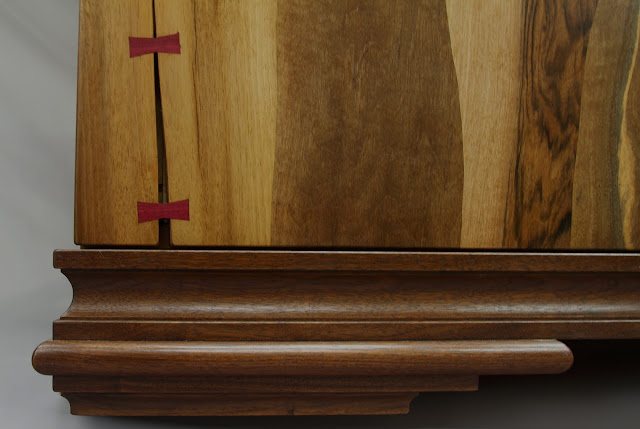607 - Unique in the industry, a "captured live-edge" dresser features solid panels joined on the vertical
Designed by me and built by Buck for a friend / colleague. 51 L x 24 w x 65 1/2 h. A departure from our usual but we are totally comfortable with this style and medium. This piece in our opinion begs to sit alongside an entire body of work.
The woods used are Oregon Walnut on the dark side, and Oregon Myrtle on the light side. Eastern Walnut top and base.
Right side.
Here it shows some of the crazy boards we used for this project. These were all considered "seconds" and not much better than throwaway wood. Thicknesses varied widely within each board from one end to another, and there were some unusable places that had to be cut away. The dresser was built as a demonstration of the fact that curvy boards can be used and joined together just as they are, in order to save massive amounts of wood from being wasted. Normally, curved boards are considered waste and are burned or chipped. Unfortunately, the sawmill in this case decided to at least attempt to get these boards somewhat linear, and therefore cut off parts that we might have considered prime.
Playing with the beginnings of a rough layout.
The finished piece stayed true to the original idea, as well it should. (Unless Suzie changes her mind)
A stack of the final boards, rough-cut.
It was my bright idea to have the "wild" corner look as if there was a tree growing up the side. Toward this end, a single board wraps the corner. Having solid boards arranged perpendicular to the long edges of the drawer is quite technically challenging.
Isn't this figure wild? All the colors are natural and unaltered, except for oiling the wood with multiple coats of penetrating finish. It shows how much variegation we can expect in our lovely native Oregon Walnut.
This shows the joint between the walnut side and the lighter Oregon Myrtle side.
The wildest place on the Oregon Walnut side. Does it look like a kiss?
In comparison with the Oregon walnut on the front and side, the Eastern walnut (top and base) is relatively tame. We used this lovely Eastern walnut deliberately on the feet and top, to "frame" the wild picture in between and to visually ground and stabilize the piece.
A drawer front showing a cross section of the joint; a tight tongue and groove. Joints on the thicker top are double tongue and groove but unfortunately don't show very much because of the darkness of the wood.
Drawer construction: We decided that slips of raw steel made the perfect pulls. These are finished so they don't rub off black onto clothes, but as much of the patina was left as possible.
View showing pulls, front, and top.
From a bird's perspective, the top appears lighter than the front, but from normal human viewing angles the top and the feet are equally dark and the front is a bit lighter. This picture shows the curvilinear joints of the top. Each of these is a double tongue and groove joint. Some are rather radically curved such as the joint that goes careening around one of the knots toward the back.




















































